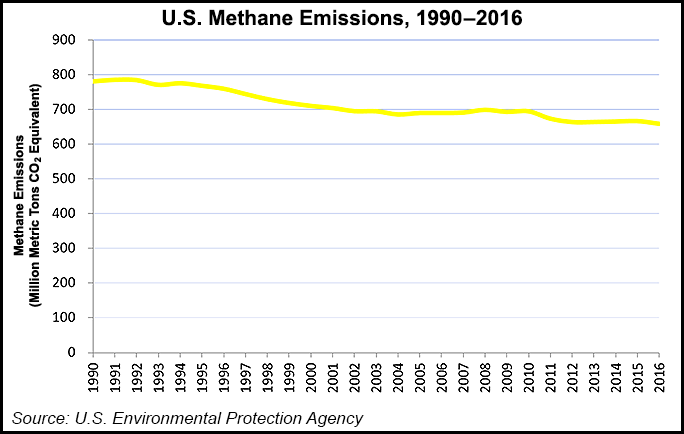E&P | NGI All News Access | NGI The Weekly Gas Market Report
Big Oil Setting Big Target on Methane Emissions
Thirteen of the biggest oil and natural gas producers in the world agreed Monday to target by 2025 a 20% reduction in the average methane intensity of aggregated upstream operations to below 0.25%.

Achieving the agreed intensity target of 0.25% by the end of 2025 would reduce collective emissions by 350,000 metric tons/year, compared to the baseline of 0.32% in 2017, according to the Oil and Gas Climate Initiative (OGCI).
The producers have a goal to reduce methane emissions by one-third. Methane intensity, i.e. methane lost in the atmosphere when producing oil and gas as a percentage of gas sold, represents a “significant milestone in tackling a key issue in the fight against climate change,” the OGCI said.
The targets underline the OGCI members’ stances to support the goals of the global climate change accord, aka the Paris Agreement, reached in late 2015.
“Our aim is to work toward near zero methane emissions from the full gas value chain in support of achieving the goals of the Paris Agreement,” the heads of the member companies said. “We have worked to make our ambition concrete, actionable and measurable, helping to ensure that natural gas can realize its full potential in a low-emissions future.”
To reduce collective methane emissions intensity, plans are to target key emissions sources and engage with other energy industry companies to help ensure that methane emissions are addressed across the full gas value chain.
The updated methane target comes only days after U.S.-based Chevron Corp., ExxonMobil Corp. and Occidental Petroleum Corp., which together represent 5% of global oil and gas production, joined the OGCI.
Launched in 2014, other members are BP plc, China National Petroleum Corp., Eni SpA, Equinor ASA, Petroleos Mexicanos, Petroleo Brasileiro SA, Repsol SA, Royal Dutch Shell plc, Saudi Aramco and Total SA.
Through the $1 billion OGCI Climate Investments fund, the group aims to increase the “ambition, speed and scale of initiatives to reduce greenhouse gases.” CNPC also is partnering with OGCI to create a climate investments fund specific to China.
To achieve its goals by 2025, companies still need to adopt “more robust measurement protocols than the estimates widely used today, according to the Environmental Defense Fund (EDF).
“This is a good strong goal, and these companies deserve real credit for that,” said EDF President Fred Krupp. “The OGCI ambition sets a new bar by which the whole industry will be measured. Ultimately, the true test of leadership is transparency and results. It will be critical now for companies to follow through on their commitment, reporting on progress with actual measured emissions, fully and publicly disclosed.
“A second challenge for OGCI is the risk that laggards in the industry hide behind their efforts, falsely claiming that the actions of an important few represent what all in the industry are doing. What we’ve learned through hard experience in the U.S. is that voluntary efforts of leaders are no substitute for government policies that level the playing field for all.”
© 2024 Natural Gas Intelligence. All rights reserved.
ISSN © 1532-1231 | ISSN © 2577-9877 | ISSN © 1532-1266 |
